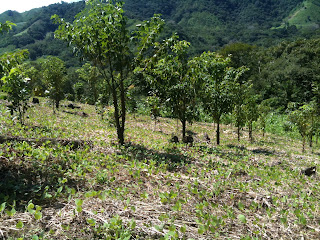Mixed Plantations (Mahogany, Roble, Pochote) with crops |
We agree that planting selected species of trees, sometimes exotics, in perfect rows is not the same as recreating a natural forest, but its better than what was there before. . . a cow pasture. These trees, even if they are pure teak stands, will protect the soil, water systems, and capture carbon. To date we can’t find a more stable environmentally sound investment.
The tropical plantation system is proven and will be an important part of the future of forestry. One of the world’s only renewable natural resources can be grown as a crop, albeit long-term. Growing wood in plantations captures carbon but also when the trees are cut down the carbon is actually stored in the form of wood which is a carbon sink. In a natural forest the trees die and actually release carbon and other gases.
 |
| Beans and 1 year old Pochote |
The growth in tropical plantations has been significant in the last few decades and we see this trend continuing. The current model of pure stands of timber with manual labor used for maintenance we find inefficient. We realized this in our work when we watched our workers clean the trees with a machete and then go home and swing the machete on an empty lot to plant beans. Basically we were paying them to do something they and their neighbors do already when they plant their subsistence crops. Why not plant the beans under the trees?
We feel that a truly efficient and sustainable model for timber plantations will include short term cash crops. These crops can actually add nutrients to the soil that make the trees grow faster. For example, beans fix nitrogen and in our experiences trees planted with beans grow almost twice as fast in the early years as neighboring parcels with no beans. In addition the farmers who plant the beans tend to keep the area cleaner than our workers so there is less competition from weeds which slow the growth of the trees.
 |
| Look how tall this one year old pochote is mixed with corn |





